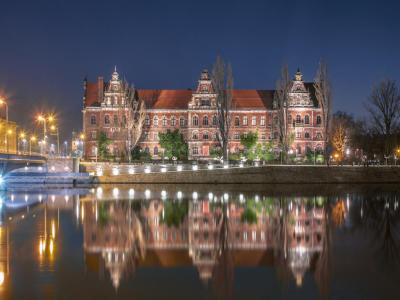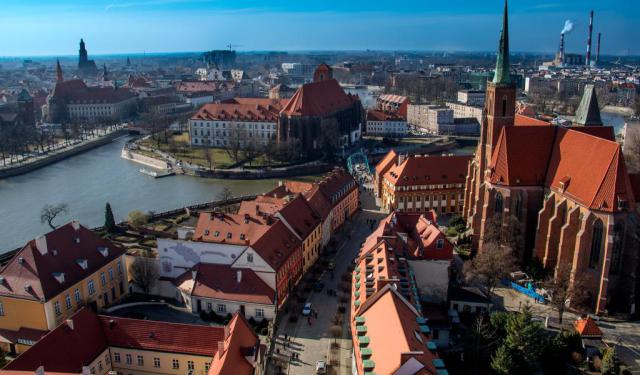
Muzeum Narodowe (National Museum), Wroclaw
The National Museum in Wrocław is a significant cultural institution established on March 28, 1947, and officially inaugurated on July 11, 1948. As one of Poland's integral branches of the National Museum system, it stands out for its extensive collection of contemporary art, making it a vital hub for modern creative expressions within the country.
The origins and holdings of the Wrocław Museum are intimately intertwined with the tumultuous history of border shifts in Central Europe following the aftermath of World War II. Particularly noteworthy was the annexation of the eastern half of the Second Polish Republic by the Soviet Union. As a consequence, many valuable art collections from cities incorporated into the USSR, such as Lviv, faced relocation and dispersion.
The Wrocław Museum played a pivotal role as it received a portion of Poland's art collections. These transferred collections included Polish and European paintings spanning the 17th to 19th centuries, offering a captivating glimpse into the art and history of the region.
The museum's exhibition spaces are organized into four distinct departments, each dedicated to specific art periods and historical epochs. The first department, "Silesian Art of the 12th to 16th century," provides a window into the past with tombs of Silesian princes and a remarkable array of Gothic art treasures. Moving forward, the "Silesian Art of the 16th to 19th century" department offers a comprehensive journey through sculpture, painting, and decorative arts, encompassing the Silesian Renaissance to Romanticism.
For enthusiasts of Polish art, the "Polish Art of the 17th to 19th century" department presents a rich tapestry of masterpieces. This section includes Polish Baroque portraits by renowned artists like Marceli Bacciarelli and Canaletto, contributing to a deeper understanding of Poland's artistic legacy.
Lastly, the "European Art of the 15th–20th Century" department showcases a diverse range of artworks from across the continent, spanning five centuries. This comprehensive collection allows visitors to explore European artistic movements and styles, offering a captivating panorama of creative expressions.
The origins and holdings of the Wrocław Museum are intimately intertwined with the tumultuous history of border shifts in Central Europe following the aftermath of World War II. Particularly noteworthy was the annexation of the eastern half of the Second Polish Republic by the Soviet Union. As a consequence, many valuable art collections from cities incorporated into the USSR, such as Lviv, faced relocation and dispersion.
The Wrocław Museum played a pivotal role as it received a portion of Poland's art collections. These transferred collections included Polish and European paintings spanning the 17th to 19th centuries, offering a captivating glimpse into the art and history of the region.
The museum's exhibition spaces are organized into four distinct departments, each dedicated to specific art periods and historical epochs. The first department, "Silesian Art of the 12th to 16th century," provides a window into the past with tombs of Silesian princes and a remarkable array of Gothic art treasures. Moving forward, the "Silesian Art of the 16th to 19th century" department offers a comprehensive journey through sculpture, painting, and decorative arts, encompassing the Silesian Renaissance to Romanticism.
For enthusiasts of Polish art, the "Polish Art of the 17th to 19th century" department presents a rich tapestry of masterpieces. This section includes Polish Baroque portraits by renowned artists like Marceli Bacciarelli and Canaletto, contributing to a deeper understanding of Poland's artistic legacy.
Lastly, the "European Art of the 15th–20th Century" department showcases a diverse range of artworks from across the continent, spanning five centuries. This comprehensive collection allows visitors to explore European artistic movements and styles, offering a captivating panorama of creative expressions.
Want to visit this sight? Check out these Self-Guided Walking Tours in Wroclaw. Alternatively, you can download the mobile app "GPSmyCity: Walks in 1K+ Cities" from Apple App Store or Google Play Store. The app turns your mobile device to a personal tour guide and it works offline, so no data plan is needed when traveling abroad.
Muzeum Narodowe (National Museum) on Map
Sight Name: Muzeum Narodowe (National Museum)
Sight Location: Wroclaw, Poland (See walking tours in Wroclaw)
Sight Type: Museum/Gallery
Guide(s) Containing This Sight:
Sight Location: Wroclaw, Poland (See walking tours in Wroclaw)
Sight Type: Museum/Gallery
Guide(s) Containing This Sight:
Walking Tours in Wroclaw, Poland
Create Your Own Walk in Wroclaw
Creating your own self-guided walk in Wroclaw is easy and fun. Choose the city attractions that you want to see and a walk route map will be created just for you. You can even set your hotel as the start point of the walk.
Cathedral Island Walking Tour
Cathedral Island, known as "Ostrów Tumski" in Polish, is a historic and enchanting district in the heart of Wroclaw. This picturesque island, nestled amid the Oder River, is a treasure trove of architectural and cultural wonders that date back centuries.
Begin your journey by crossing the iconic Tumski Bridge. It's not just a pathway but a symbol of love, as couples often attach... view more
Tour Duration: 1 Hour(s)
Travel Distance: 0.7 Km or 0.4 Miles
Begin your journey by crossing the iconic Tumski Bridge. It's not just a pathway but a symbol of love, as couples often attach... view more
Tour Duration: 1 Hour(s)
Travel Distance: 0.7 Km or 0.4 Miles
Wroclaw Introduction Walking Tour
Wroclaw, the capital of Poland’s Lower Silesia province, is a travel gem for wandering hearts. Steeped in over 1,000 years of history and a vibrant blend of Polish, German, and other cultural influences, it could easily compete for the title of the most beautiful city in Europe.
The area around Wroclaw was inhabited as early as the 9th century by Slavic tribes. The town was originally part of... view more
Tour Duration: 2 Hour(s)
Travel Distance: 3.7 Km or 2.3 Miles
The area around Wroclaw was inhabited as early as the 9th century by Slavic tribes. The town was originally part of... view more
Tour Duration: 2 Hour(s)
Travel Distance: 3.7 Km or 2.3 Miles


